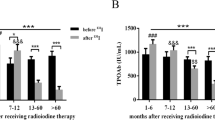Abstract
Relapses of hyperthyroidism after treatment with radioiodine for uni- or multi-nodular goiter may be accompanied by the appearance of TSAb. However, this phenomenon has only emerged from one retrospective study on Northern European patients, in which it was not possible to determine whether TSAb also appeared in treated patients who did not relapse. The present study aimed to assess the appearance, immunogenic nature and clinical characteristics of hyperthyroidism relapse after treatment with 131I for nodular toxic goiter in patients from the Mediterranean area. A retrospective study was performed on 76 consecutive patients, born and resident in Sicily and aged 56-80 yr at diagnosis, who were treated with radioiodine. Serum aliquots obtained from the patients before 131I treatment and during a follow-up of 36-144 months were assayed for TSAb and TPOAb. The clinical charts of the patients were also re-examined. Twenty-six out of 76 patients (36.8%) had a hyperthyroidism relapse after a first treatment with 131I. Eight of the 26 (30.7%) also relapsed after the second treatment. Three out of 26 (11.5%) relapsed after a third treatment. The 50 patients who required only one treatment and the 18 who relapsed only once were all TSAb-negative at baseline, while 3/8 (37.5%) who relapsed also after the second treatment were already TSAb-positive at baseline. TSAb became positive in 3/18 patients (16.7%) who relapsed once, and in 4/8 (50.0%) of those who relapsed after a second treatment. One of these 7 TSAb-positive relapsers was also already TPOAb-positive at baseline and another became TPOAb-positive after treatment. The presence of circulating TSAb in 3/76 (3.9%) patients before treatment for toxic goiter more probably points to a diagnosis of Marine-Lenhart’s syndrome. In contrast, the de novo appearance of TSAb in the presence of hyperthyroidism relapse in 4/76 (5.3%) patients suggests the development of a Graves’-like disease after radioiodine treatment. This occurrence does not seem to have precise ethnic grounds, since the incidence we observed in Mediterranean patients was similar to that previously reported in Northern European patients.
Similar content being viewed by others
References
Boddenberg B., Voth E., Scicha H. Immunogen hyper-thireose nach Radiojod-ablation einer fokalen autonomie. Nucl. Med. 1993, 32: 18–22.
Chiovato L., Santini F., Vitti P., Bendinelli G., Pinchera A. Appearance of thyroid stimulating antibody and Graves’ disease after radioiodine therapy for toxic nodular goiter. Clin. Endocrinol. 1994, 40: 803–806.
Nygaard B., Faber J., Veje A., Hegedus L., Hansen J.M. Transition of nodular toxic goiter to autoimmune hyperthyroidism triggered by 131-I therapy. Thyroid 1999, 9: 477–481.
Nygaard B., Knudsen J.H., Hagedus L., Scient A.V., Hansen J.E. Thyrotropin receptor antibodies and Graves’ disease, a side-effect of 131-I treatment in patients with nontoxic goiter. J. Clin. Endocrinol. Metab. 1997, 82: 2926–2930.
Smyth P.P.A., Neylan D., McMullan N.M., Smith D.F., McKenna T.J. Sequential presentation of a case of hyperthyroidism with autonomously functioning nodules and Graves’ disease in the presence of IgG thyroid stimulators. Acta Endocrinol. (Copenhagen) 1988, 118: 474–478.
Regalbuto C., Salamone S., Scollo C., Vigneri R., Pezzino V. Appearance of anti TSH-receptor antibodies and clinical Graves’ disease after radioiodine therapy for hyperfunctioning thyroid adenoma. J. Endocrinol. Invest. 1999, 22: 147–150.
Orsolon P., Lupi A., de Antoni Migliorati G., Vianello Dri A. Appearance of Graves’-like disease following regression of autonomously functioning thyroid nodules. Two case reports. Minerva Endocrinol. 1998, 23: 53–56.
Weiss M., Gorges R., Hirsch C., Bader J., Tatsch K., Hahn K. Incidence of immunogenic hyperthyroidism after radioiodine therapy of focal thyroid gland autonomy. Results of a multicenter study. Med. Klin. 1999, 94: 239–244.
Szebeni A., Beleznay E. New simple method for thyroid volume determination by ultrasonography. J. Clin. Ultras. 1992, 20: 329–337.
Nygaard B., Hagedus L., Nielsen K.G., Ulriksen P., Hansen J.M. Long-term effect of radioactive iodine on thyroid function and size in patients with solitary autonomously functioning toxic thyroid nodules. Clin. Endocrinol. 1999, 50: 197–202.
Nygaard B., Hagedus L., Ulriksen P., Nielsen K.G., Hansen J.M. Radioiodine therapy for multinodular toxic goitre. Arch. Intern. Med. 1999, 159: 1364–1368.
Chandramouly B., Man D., Cunnigham R.P., Geigerrich E. Marine-Lenhart syndrome: Graves’ disease with poorly functioning nodules. Clin. Nucl. Med. 1992, 17: 905–906.
Nishikawa M., Yoshimura M., Yoshikawa N. et al. Coexistence of an autonomously functioning thyroid nodule in a patient with Graves’ disease: an unusual presentation of Marine-Lenhart’s syndrome. Endocr. J. 1997, 44: 571–574.
Patibandla S.A., Prabhakar B.S. Autoimmunity to the thyroid stimulating hormone receptor. Adv. Neuroimmunol. 1996, 6: 347–357.
Feldt-Rasmussen U., Bech K., Date J., Petersen P.H., Johansen K. A prospective study of the differentia changes in serum thyroglobuline and its autoantibodies during propylthiouracil or radioiodine therapy of patients with Graves’ disease. Acta Endocrinol. (Copenhagen) 1982, 99: 379–385.
Weetman A.P., McGregor A.M. Autoimmune thyroid disease: developments in our understanding. Endocr. Rev. 1984, 5: 309–355.
Kay T., Heyma P., Harrison L., Martin F.I.R. Graves’ disease induced by radioactive iodine. Ann. Intern. Med. 1987, 107: 857–858.
Author information
Authors and Affiliations
Corresponding author
Rights and permissions
About this article
Cite this article
Custro, N., Ganci, A. & Scafidi, V. Relapses of hyperthyroidism in patients treated with radioiodine for nodular toxic goiter: Relation to thyroid autoimmunity. J Endocrinol Invest 26, 106–110 (2003). https://doi.org/10.1007/BF03345136
Accepted:
Published:
Issue Date:
DOI: https://doi.org/10.1007/BF03345136




